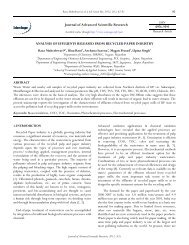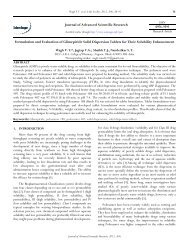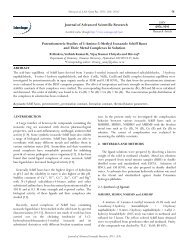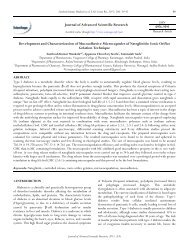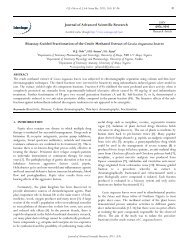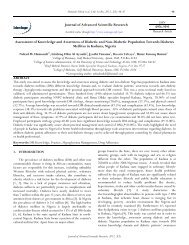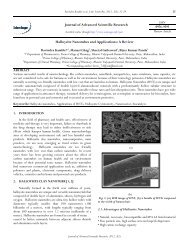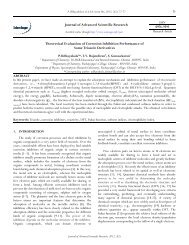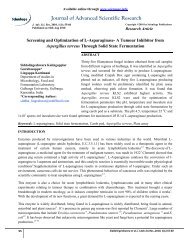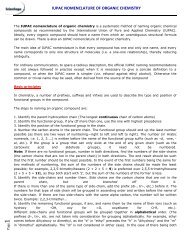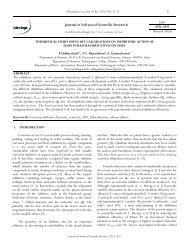Density Functional Theory Investigations for the ... - Sciensage.info
Density Functional Theory Investigations for the ... - Sciensage.info
Density Functional Theory Investigations for the ... - Sciensage.info
Create successful ePaper yourself
Turn your PDF publications into a flip-book with our unique Google optimized e-Paper software.
HOMO of Inh-II<br />
LUMO of Inh-II<br />
Figure 2. Frontier molecular orbital diagrams of Inh-I and<br />
Inh-II by B3LYP/6-31G (d,p)<br />
The use of Mulliken population analysis to estimate <strong>the</strong><br />
adsorption centres of inhibitors has been widely reported and it<br />
is mostly used <strong>for</strong> <strong>the</strong> calculation of <strong>the</strong> charge distribution<br />
over <strong>the</strong> whole skeleton of <strong>the</strong> molecule [56]. There is a<br />
general consensus by several authors that <strong>the</strong> more negatively<br />
charged heteroatom, is <strong>the</strong> more it can be adsorbed on <strong>the</strong><br />
metal surface through <strong>the</strong> donor-acceptor type reaction. It is<br />
important to consider <strong>the</strong> situation corresponding to a<br />
molecule that is going to receive a certain amount of charge at<br />
some centre and is going to back donate a certain amount of<br />
charge through <strong>the</strong> same centre or ano<strong>the</strong>r one[44] . Parr and<br />
Yang proposed that larger value of Fukui function indicate<br />
more reactivity [27]. Hence greater <strong>the</strong> value of condensed<br />
Fukui function, <strong>the</strong> more reactive is <strong>the</strong> particular atomic<br />
centre in <strong>the</strong> molecule.<br />
The local reactivity of molecule Inh-I and Inh-II is analyzed<br />
by means of <strong>the</strong> condensed Fukui function. The condensed<br />
Fukui function and local softness indices allow one distinguish<br />
each part of <strong>the</strong> molecule on <strong>the</strong> basis of its distinct chemical<br />
behavior [57] due to <strong>the</strong> different substituted functional group.<br />
+<br />
The f k , measures <strong>the</strong> changes of density when <strong>the</strong> molecules<br />
gains electrons and it corresponds to reactivity with respect to<br />
nucleophilic attack. On <strong>the</strong> o<strong>the</strong>r hand, f k- corresponds to<br />
P. Udhayakala et al, J Adv Sci Res, 2012, 3(3): 67-74 72<br />
Journal of Advanced Scientific Research, 2012, 3(3)<br />
reactivity with respect to electrophilic attack or when <strong>the</strong><br />
molecule loss electrons. For electrophilic attack <strong>the</strong> most<br />
reactive site of Inh-I and Inh-II is on <strong>the</strong> N(5)atoms and <strong>for</strong><br />
nucleophilic attack <strong>the</strong> most reactive site is C(2) in Inh-I and<br />
C(13) in Inh-II. The electrophilic and nucleophilic attacks of<br />
molecule Inh-I and Inh-II are tabulated in table 4 and 5.<br />
Table 4. Fukui and local softness indices <strong>for</strong> electrophilic and<br />
nucleophilic attacks in Inh-I atoms calculated from<br />
Mulliken atomic charges.<br />
Atom f - f + s k<br />
-<br />
1 C 0.03383 0.061893 0.0152298 0.0278633<br />
2 C 0.03383 0.061894 0.0152298 0.0278638<br />
3 O 0.021531 0.048561 0.009693 0.0218615<br />
4 N 0.078777 0.035311 0.0354643 0.0158965<br />
5 N 0.078778 0.035309 0.0354648 0.0158956<br />
6 C -0.014465 0.009912 -0.006512 0.0044622<br />
7 C 0.03313 0.028687 0.0149147 0.0129145<br />
8 C 0.031137 0.020411 0.0140174 0.0091887<br />
9 C 0.019532 0.003919 0.008793 0.0017643<br />
10 H 0.035872 0.035954 0.0161491 0.0161859<br />
11 C 0.015236 0.008791 0.006859 0.0039575<br />
12 H 0.043691 0.045359 0.0196691 0.0204199<br />
13 C 0.012319 0.020958 0.0055458 0.0094349<br />
14 H 0.051133 0.052006 0.0230194 0.0234124<br />
15 H 0.05204 0.05445 0.0234277 0.0245126<br />
16 C -0.014467 0.009915 -0.006513 0.0044636<br />
17 C 0.033133 0.028689 0.014916 0.0129154<br />
18 C 0.031132 0.020411 0.0140152 0.0091887<br />
19 C 0.01955 0.003889 0.0088011 0.0017507<br />
20 H 0.035875 0.035952 0.0161504 0.0161851<br />
21 C 0.015232 0.008809 0.0068572 0.0039657<br />
22 H 0.043689 0.045359 0.0196682 0.0204199<br />
23 C 0.012306 0.020967 0.00554 0.0094390<br />
24 H 0.051128 0.052011 0.0230171 0.0234146<br />
25 H 0.052036 0.054451 0.0234259 0.0245131<br />
26 C -0.011248 -0.008401 -0.005064 -0.0037820<br />
27 H 0.040613 0.042586 0.0182834 0.0191716<br />
28 H 0.037754 0.031304 0.0169963 0.0140926<br />
29 H 0.029896 0.032573 0.0134588 0.0146639<br />
30 C -0.011256 -0.008394 -0.005067 -0.0037789<br />
31 H 0.040569 0.042599 0.0182636 0.0191775<br />
32 H 0.03775 0.031362 0.0169945 0.0141187<br />
33 H 0.02994 0.032502 0.0134786 0.0146319<br />
Table 5. Fukui and local softness indices <strong>for</strong> electrophilic and<br />
nucleophilic attacks in Inh-II atoms calculated from<br />
Mulliken atomic charges.<br />
Atom f - f + -<br />
s k<br />
+<br />
s k<br />
1 C 0.026839 0.063836 0.0124751 0.0296718<br />
2 C 0.026839 0.063834 0.0124751 0.0296708<br />
3 O 0.016910 0.045862 0.0078553 0.0213172<br />
4 N 0.068799 0.028549 0.0319787 0.0132699<br />
5 N 0.068810 0.028549 0.0319791 0.0132699<br />
6 C -0.013063 0.001023 -0.006072 0.0004755<br />
7 C 0.028533 0.035851 0.0132625 0.0166640<br />
8 C 0.030487 0.020413 0.0141708 0.0094882<br />
s k<br />
+<br />
Continued…



